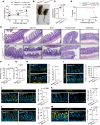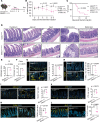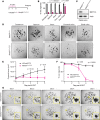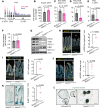Intestinal transit-amplifying cells require METTL3 for growth factor signaling and cell survival
- PMID: 37883185
- PMCID: PMC10795831
- DOI: 10.1172/jci.insight.171657
Intestinal transit-amplifying cells require METTL3 for growth factor signaling and cell survival
Abstract
Intestinal epithelial transit-amplifying cells are essential stem progenitors required for intestinal homeostasis, but their rapid proliferation renders them vulnerable to DNA damage from radiation and chemotherapy. Despite these cells' critical roles in intestinal homeostasis and disease, few studies have described genes that are essential to transit-amplifying cell function. We report that RNA methyltransferase-like 3 (METTL3) is required for survival of transit-amplifying cells in the murine small intestine. Transit-amplifying cell death after METTL3 deletion was associated with crypt and villus atrophy, loss of absorptive enterocytes, and uniform wasting and death in METTL3-depleted mice. Sequencing of polysome-bound and methylated RNAs in enteroids and in vivo demonstrated decreased translation of hundreds of methylated transcripts after METTL3 deletion, particularly transcripts involved in growth factor signal transduction such as Kras. Further investigation verified a relationship between METTL3 and Kras methylation and protein levels in vivo. Our study identifies METTL3 as an essential factor supporting the homeostasis of small intestinal tissue via direct maintenance of transit-amplifying cell survival. We highlight the crucial role of RNA modifications in regulating growth factor signaling in the intestine with important implications for both homeostatic tissue renewal and epithelial regeneration.
Keywords: Adult stem cells; Gastroenterology; Homeostasis; RNA processing.
Conflict of interest statement
Figures








Update of
-
Intestinal transit amplifying cells require METTL3 for growth factor signaling, KRAS expression, and cell survival.bioRxiv [Preprint]. 2023 Apr 21:2023.04.06.535853. doi: 10.1101/2023.04.06.535853. bioRxiv. 2023. Update in: JCI Insight. 2023 Dec 8;8(23):e171657. doi: 10.1172/jci.insight.171657. PMID: 37066277 Free PMC article. Updated. Preprint.
References
Publication types
MeSH terms
Substances
Grants and funding
LinkOut - more resources
Full Text Sources
Medical
Molecular Biology Databases
Miscellaneous

